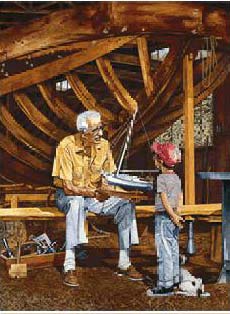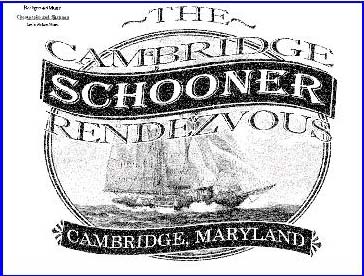| When I came across the Richardson
Maritime Museum website, I was looking for plans to a Chesapeake
Bay Bugeye. I was contemplating a Bugeye as a live aboard for
myself. Rummaging through the website gave me the impression that
Jim Richardson wasn’t just admired for his skill as a boatbuilder,
he was loved as a man. This is so true that when he died in 1991,
the community of Cambridge, Maryland took immediate steps to hold
on to what he loved and taught to others. Jim Richardson not only
mastered the boatbuilding skills of the 20th century, he taught
them. As a result, the Museum bearing his name reflects the man.
It is humane. It has the quality of a close-knit place where people
are the main aspect of the programs. Local residents passing by
the old brick buildings which form the museum often just step
in. They like being there. That’s Jim Richardson for you,
that’s what he was like. He could tell you what the old
wooden dredgers looked like and he could put a boy’s fingers
on a varnished curve of wood. His eyes knew how hard the life
on the Chesapeake was, yet his voice knew the good men who settled
the Bay.
 |
George Wright’s Master Boatbuilder, 1985,
available from the Richardson Maritime Museum. |
For hundreds of years, wood surrounded the Chesapeake. Wood-framed
homes, wood docks and plenty of wooden boat yards lined the banks
of the Bay. The men here made crabbing skiffs to dovetails to
schooners to clipper ships. Jim Richardson grew up learning the
skills of the old wood boats and he passed them along. Now the
museum can show you those times and places by the models of skipjacks,
bugeyes, dredgers, clam diggers, privateers and schooners. These
are not plastic model kits. They are models build by local men,
often boatbuilders themselves. Not only that, the museum has a
collection of the tools the men used to build wooden craft from
10 to 100 feet long. Yet, modelling is not all that’s going
on. At the Ruark Boatshop - named after modeler Harold Ruark -
local kids have jumped in the Youth Build A Boat program. They’re
from the Philadelphia Springside School. Twenty-two girls participated
under the supervision of the Boatworks volunteers. There’s
nothing wrong with the kids of today that chopping wood before
breakfast wouldn’t cure, so these kids are learning boatbuilding
skills, history, and the heritage of their own waterfront. Not
only are the old guys teaching the young girls, but the Museum
is restoring the Jolly Dolphin and the Flora A. Price.
The Jolly Dolphin was originally built by Jim Richardson
himself, while the Flora A. Price was the largest surviving
skipjack in the Chesapeake Bay. This work can only be done if
the old guys pass along the skills they possess to the younger
whipper-snapper generation. A great program of mentoring is the
SKIFF Program (Skills, Knowledge, Initiative, Foundation and Friendship).
Here traditional boatbuilding skills are learned by a mentor and
mentee. Then they in turn teach and mentor another group of mentors
and mentees, who do the same for another group. The old 19th century
habit of hoarding skills won’t work if we want to preserve
and continue our traditions.
This is just a great place. It’s a hands-on place which
isn’t so expensive as some other museums and boat schools.
If you’re an old guy loitering around at dinner time, go
on over to the Museum. They’ll put you to work. You might
even get to work with one of those young teenaged girls - now
that’ll get you outta the sack in the morning.
My other favorite museum is a long ways from Maryland, the San
Diego Maritime Museum. I visited there a couple of years ago.
My God, this place is heaven. No wonder Dennis Conner lived there.
The San Diego Museum is quite a different place. They have taken
on the responsibility of seven big craft, including the Surprise
featured in the movie Master and Commander. This takes
a big budget and San Diego has the donors for this. Think of the
yacht club scene in Caddyshack. While I wasn’t
born into such gilded circles, we need to take care of historical
ships.

Stepping onto a square-rigger is an awesome feeling. The Surprise
is huge, it’s wide, it’s thick under your feet, it’s
powerfully built with more lines than a Rodney Dangerfield routine.
Joseph Conrad once described the sails on a square rigger as a
‘pyramid of sail.’ You get that feeling looking up
at those fat solid masts hanging spars where men stand thirty
feet in the air, lines crisscrossing your sight like a cathedral
roof latticework. The Rose under way shoves the ocean out of the
way and with foam alongside its planks Rose crushes any waves
underneath while trapping the wind that whistles above. The Rose
is loud. Lines clatter and whine through their pulleys, boards
creak and men yell. If you wanted to be the captain in Nelson’s
Navy, you had better learn how to yell. The technique is to always
be upwind otherwise your laryngitis would go unappreciated. If
you can look mean while you do it, all the better.
Their schooner is the Californian, the state supported
topsail schooner. Compare to the Surprise, the Californian
is a real needle through holes in the wind. Its fore and aft gaff
rigged sails make a schooner feel slender and pointed. Close-hauled,
the Californian really seems to scud close to the wind
compared to a square-rigger. While the Rose is a knuckle-punch,
the Californian is a leaning slit between wind and water.
 |
Contrary to popular opinion, a topsail schooner
with an overlapping main is swift. It seems to puncture the
water while it draws the ocean beneath its bilges. The sails
really guide the wind on a schooner. While on the Surprise,
the square sails get smacked by the wind with whirling eddies
of air to keep the ship on its waterline. |
The Californian’s gaffs give and haul in the wind,
almost cupping it to hand it off from the foresail to the mainsail.
I felt the thrill of a great ship whirl through the San Diego
Bay on the Californian - like running downhill.
The Museum also manages six other ships. They have two submarines,
a 1914 pilot boat, an 1898 steam yacht, the Berkeley along steam
ferry, The Star of India and the steam yacht Medea.
The Berkeley was used on San Francisco Bay. She rescued hundreds
of people in the San Francisco earthquake of 1904, even while
the crew had no idea where their own families were. This ferry
houses the Museum offices, a library, workshop, model shop and
special events room for 800. It also has the best museum store
I’ve ever been in. It’s the kind of store with such
nautical stuff all around in which you don’t really want
to leave. When I was there, I saw a young girl sitting on the
floor in a corner reading a book so intently I could have rolled
a ten dollar bill past her without her looking up. I wonder if
she’s like this in school.
The Star of India has a shady past. It was built in
1863 in England as a cargo clipper to India. As one of the first
steel-hulled ships it was given a low aspect square rig to handle
the seas. Still on its first voyage to India, it suffered a collision
and a mutiny. While it was in the Bay of Bengal, a tornado hit,
so the topmasts had to be cut down for it to make port at all.
Shortly after ward the captain died. After that, the Star made
four more voyages from England to India. It was sold to the Shaw-Saville
Company in 1871, re-rigged as a barque, and used to transport
immigrants from the British Isles to New Zealand and Australia.
The immigrants had it rough on the between deck, with nothing
to eat but hard tack and soup, but they made it. It has made twenty-one
circumnavigations at this point. The museum has one of the best
publications I’ve ever seen, called Mains’l Haul.
The articles are from scholars in marine biology, Pacific history,
sailing history, and related subjects. This is a beautiful 100
page magazine which takes me about three days to read. The Richardson
Museum and the San Diego Museum are very different museums, but
both of them mare a reflection of our history and the joy of sailing.
They both do a great deal for kids and families and charities
in their area. I wouldn’t want to do without either. One
final note for the Richardson Museum, please mark your calendars
for October 23-25 at the Long Wharf Park on the Choptank River
in the Chesapeake. The city of Cambridge is having the CAMBRIDGE
SCHOONER RENDEZVOUS.

Six schooners will be there along with food, music, entertainment
and high class strolling. The schooners are Pride of
Baltimore II, Mystic Whaler, Martha
White, Lady Maryland, Heron, and Prom
Queen. Also appearing will be the skipjack Nathan of
Dorchester.
by Paul Austin

|

